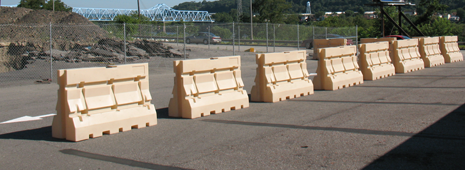The Jersey barrier, as you see it on the road today, has more than 50 years of innovation behind it. These barriers were first used on a rather dangerous section of the mountain road in California as early as 1946. But it was developed at the Stevens Institute of Technology in Hoboken New Jersey under the guidance of the New Jersey State Highways Department- hence the name.
These barriers are also known as K-rails in some of the western states, no doubt a reference to the California Department of Transportation’s guidelines for temporary concrete traffic barriers.
Though the Jersey barrier is the most popular of the modular concrete barriers there are about six variations to the vanilla version. The similar shape is used on one-sided roadside barriers.
The barrier was tested in Canada by the Department of Highways in Ontario in 1968. What followed was a variation of the Jersey barrier design; 10 inches taller at 42 inches and was called the Ontario Tall Wall.
Another variant of the Jersey barrier has been the Bremer wall which is 12 feet high, is portable and used against blasts throughout the war zones in Iraq and Afghanistan.
The Bremer wall is also called the Texas barrier because it is larger but similar in appearance to the Jersey barrier. The largest barriers, called Alaska barriers, are 20 feet high. Texas and the Alaska barriers have a rectangular ledge on which a person can sit, while the Jersey barrier slopes off at the base.
The Texas barrier is quite different from the Texas Constant Slope barrier which is used for traffic control. The Texas Constant Slope barrier is made of reinforced concrete with a single slope and is used to separate traffic lanes.
The main advantage the Constant Slope has is that it has vertical concrete walls which help during the resurfacing or repaving of the roadbed, as the variations in height of the asphalt do not affect its efficiency. These barriers have been particularly effective on curved ramps.
The other variation of the Jersey barrier is the F-Shape barrier which is taller, with a lesser gradient and a lower bottom section. Interestingly, this barrier is called the F-Shape because it was the sixth configuration tested in a 1976 research by the Federal Highway Administration.
The F-Shape is used where permanent concrete barriers are required. This kind of barrier has proved to be more successful than the Jersey barrier.
Another barrier which was been used, albeit briefly, is the GM barrier, but it has been obsolete for some time. However, this barrier, which is a bulkier version of the Jersey barrier, was designed by General Motors along with the Texas Transportation Institute back in the 1970s, when vehicles were much larger than they are now.
In the UK and Ireland, the concrete step barrier has been used extensively and is the approved as a safety device to be used as the central median on the highways. The barrier is designed to reduce injury to people inside small cars in the case of a collision. The step design also reduces the contact of the vehicle to the barrier.
Cable barriers, which consist of steel wire ropes fixed on relatively weak supports, are also used on many state highways. The primary purpose of this barrier is similar to the Jersey barrier and it is to stop a vehicle from leaving the road and colliding with an oncoming vehicle or with a fixed object. These barriers are most used to separate lanes on the highway.
A different version of the concrete barriers is the hollow polyethylene barrier, which can be filled with water on-site. These plastic jersey barriers can be also filled with soil, cement or spill but that would make it heavier and its main advantage- its portability – would be reduced. These plastic barriers are mainly used to demarcate work zones.
While most of the modular concrete barriers look similar, the main differences between the more widely used Jersey barrier and the variations is the height of the “break point” between the top and the bottom slope, the width and the overall height.

